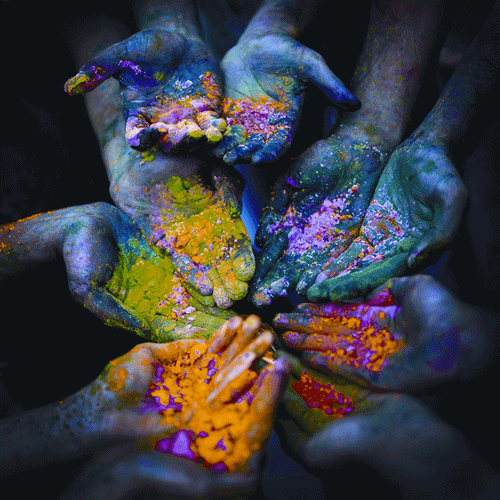Festivals & Celebration
India as a country, with its unified diversity, houses many cultures and religions. This has led to celebration of numerous festivals across the year. Each festival has its own history, legend and significance as thousands join in with passion.
One of the most colourful festivals celebrated in the world, Holi is representative of India’s essence and vibrancy. Celebrated across two days in the month of March; on the first day communities come together to burn a bonfire to commemorate the sacrifice of Holika and the next day people come out to play with colours. Among the famous places to celebrate Holi in India, Mathura, Vrindavan, Dwarka and Kumaon region of Uttarakhand are the best.
The festival of lights, Diwali is one the Indian festivals which is celebrated with great fervour and enthusiasm across the country in different ways. The word is derived from Sanskrit word Dipavali, meaning ‘rows of lighted lamps’. According to Hindu beliefs, when Rama and Sita returned to Ayodhya after an exile of 14 years after defeating Ravana, the people welcomed them with lighting of lamps. It also celebrated the day MahaDurga destroyed a demon called Mahisha. Therefore this festival also celebrates the triumph of good over evil. It is a five day festival which spreads over cleaning of the house, decoration with lights, prayers on the third day and celebrating with friends. The last day is called Bhai Dooj where the brother visits his sisters to renew their bond and celebrate with sweets.
Navratri is a nine day festival celebrated in the worship of Hindu goddesses Durga, Lakshmi and Sarawati. Devotees fast during the day and come out to celebrate through dance in the evening. It falls twice a year with the latter culminating with Dussehra, few days before Diwali. The festival is celebrated all over India but in different ways. In western area, especially in the state of Gujarat it is a joyous occasion where people step out to enjoy the Garba nights or Dandiya Raas. In West Bengal, it is celebrated as Durga Puja where people gather in pandals and worship the goddess.
Another huge religious festival of India is Eid-ul-Fitr which is followed by a month long fasting. The festival is once again a celebration of food, beliefs and culture. The Muslim community is seen celebrate through Iftar parties which see active participation from other communities as well. Cities such as Lucknow, Delhi and Hyderabad see joyous celebrations and fanfare during Eid. The festival is also symbolic of the brotherhood and cultural uniqueness of India.
Many other festivals like Bhuddha Purnima, Janmashtmi, Maha Shivratari, Pongal are celebrated with great fervour across the country. While some are region specific, some cities have taken active interest in experiencing these festivals. Many other such fairs and festivals are also celebrated to compliment our culture and traditions.

Goa Carnival is a perfect example of the vibrant culture and festive mood of the state. The four day extravaganza brings together travellers from all around the globe. There is a parade of colourful floats and troupes of revellers in costumes dancing and singing to the live music. Originally celebrated by the Catholics, it has now become a joyous occasion where the city comes alive making it a must-have experience.

A festival known for its colourful delights, Konark Dance Festival glorifies the rich heritage of this country and not just its culture. The five day festival sees renowned classical dancers from all over the country get together to pay tribute to the Sun temple at Konark. It is organised by eminent Odissi guru Gangadhar Pradhan’s Odisha (Orissa) Dance Academy in association with the Eastern Cultural Centre, Kolkata at Konark Natya Mandap in Konark. This cultural festival celebrates the Odissi, Bharathnatyam, Manipuri, Kathak and Chau dance forms in their purest form.

A celebration of the cultural heritage of the Nagas, the Hornbill Festival is one of the biggest cultural carnival of the north east. It is a weeklong celebration where all the Naga tribes come together for their cultural and traditional plight. The main events of the festival take place at the Naga Heritage Village, Kisama which is about 10 km from Kohima, the capital city of Nagaland. These events are mainly traditional dances, playing sports and singing songs from the Naga tradition.
Gujarat is known to be the land of distinct culture and one of the most widely celebrated festivals of this region is the International Kite Festival. It is celebrated every year on January 14 and also commonly known as Uttaraya and Makar Sankranti in northern India. In Tamil Nadu, this festival is celebrated as Pongal on the 15th. According to the Hindu calendar, this day marks the beginning of summer. The blue skies are dotted with colourful kites as people gather on rooftops to celebrate the festival.
Urs festival is held every year in the memory of Saint Khawaja Moinddin Chisti, known for his goodwill acts among people. Muslim pilgrims observe it at the Ajmer Sharif Dargah where the immortal remains have been entombed. The festival honours the death anniversary of the Sufi saint in the holy city of Ajmer.

